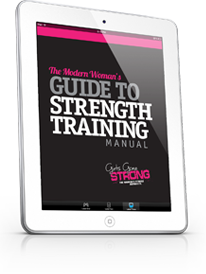Why Training Women is Different from Training Men
Everyone should know that men are from mars and women are from venus, but a concept that makes a slight bit more sense and doesn’t confuse the hell out of everyone with spurious reasoning and conclusion-jumping is simply to point out that anatomically men and women differ in how they respond to training of any kind. I’m pretty certain I’m going to come out of playing on gender differences somewhat like Schrodingers’ cat, but I like to live life on the edge, so today I’m going to outline a couple of key components to training differences between men and women that everyone should be aware of, and hopefully the hate mail is minimal and somewhat accepting.
First, let’s get the obvious out of the way. Women have different happy bits that guys do, which means anatomically there’s going to be a difference in force coupling relations throughout the core, resulting in an altered ability to produce force. The female pelvic floor has 3 openings in it (urethra, vagina, and anus), whereas the male floor only really has 2. The female pelvis is also angled at more of a transverse orientation versus saggital plane orientation, meaning the floor is stretched and stressed more during loading and hyperpressive contractions than male pelvic floors. Hyperpressive means that intraabdominal pressure increases during contraction. There’s pretty much no force producing movement that requires exertion against something externally that doesn’t increase intraabdominal pressure, so there’s that action going on.
Without getting too graphic for the squeamish in the audience, natural and ceasarian section childbirth can cause some alterations to pelvic floor reaction capacity, and also cause some muscles and nerves to become irreparably damaged, especially if delivery involved an epeisiotomy. This means that impact, heavy loading, or high anxiety/fear situations can cause some significant issues with coordinated core contractions, and even lead to some issues with incontinence, and DEFINITELY isn’t a sign of a hard workout or your awesomeness, no matter what some videos and athletes would have you think.
[embedplusvideo height=”365″ width=”600″ editlink=”http://bit.ly/1hxhvg0″ standard=”http://www.youtube.com/v/UKzq1upNIgU?fs=1″ vars=”ytid=UKzq1upNIgU&width=600&height=365&start=&stop=&rs=w&hd=0&autoplay=0&react=1&chapters=¬es=” id=”ep6965″ /]
Combine this with the fact that women have hormonal cycles that alter a lot of their body, including muscles, ligaments and tendons, and their response to exericse. Bell et al showed in THIS ARTICLE that there were definite changes in knee kinematics during a jump test during the ovulatory and mense stages of menstruation that weren’t seen at other points during the cycle in previous ACL injured athletes, and correlated increases with estradiol, progesterone and anterior knee laxity. THIS STUDY showed that knee flexion and extension strength were decreased and ACL elasticity was increased in healthy non-injured subjects during their ovulatory phase when estradiol concentrations were higher.
While that may not be good news for soccer players looking to keep their knees intact, endurance athletes can see some benefits. Shaharudin et al showed in THIS STUDY that anaerobic capacity was unaffected during any stage of ovulation, but that repeated sprint performances could help lower serum progesterone, and thus could affect the concentration of cortisol in the blood. THIS ARTICLE summarized a large body of the literature and showed that while estrogen may help endurance activities with improved carb, fat and protein metabolism and increased the oxidative potential of fatty acids, longer endurance activities that depend on the breakdown of fat to glucose may be hindered at other stages of the cycle. One common theme seemed to be the need for protein throughout menstrual cycles, so consider that impetus to eat more meat and slam shakes like Napoleon Dynamite drinking Gatorade while working on his sweet dance moves.
Guys don’t have to deal with any of this variation on a day to day basis. Our hormonal fluctuations are in a much longer phase and tends to be much more linear versus oscillating. Our testosterone tends to peak around 18 years old, slowly drops between 18 and 25, then starts to decrease a little quicker after that. Interestingly, our sexual peak occurs around 16-18 (with our peak in testosterone, but a slow steady maintenance leads to a peak “appreciation around 28-30) and women hit theirs at roughly 28-35. For all you 20 year olds out there talking about how you run so much game, come at me, bro.

Variability in menstrual cycle can be pretty huge as well. I’ve had some clients where they had no noticeable decrements in strength, endurance, power output, or variation in heart rates under set work loads, and others who would be pretty well incapacitated for 3 days each month. One even went up 3 dress sizes with her cycle, and then went down to normal 2 days later.
From a strength perspective, women tend to have a lower neural efficiency at higher resistances than men, but have a much higher muscular endurance. In rep scheme testing, men can typically work at higher loads for lower reps than they can work at higher reps. For instance, a few testing situations I’ve used would be to test 5, 3, and 1 rep max weights with a client on different sessions for common movements like a squat, deadlift, and bench press. Guys can usually do a much higher percentage on their 1 rep max than women, especially compared to their 5 and 3 rep max. A sample progression would be a deadlift:
5 reps: 315
3 reps: 385 = 22% increase over 5 rep set
1 rep: 445 = 15.5% increase over 3 rep test, 41.2% increase over 5 rep test
There was a striking increase in weight as the reps went down. Now, compare that to a recent test with a female client (numbers are raw and not scaled to body size for a reason):
5 reps: 185
3 reps: 205 = 10.8% increase over 5 rep test
1 rep: 235 = 14.6% increase over 3 rep test, 27.0% increase over 5 rep test
You can see that the weight increases much more dramatically in the male testee than the female testee, which is not a one-off assessment as it seems to be common across the spectrum.
Now, another test I use is a set weight (135 for women and 225 for men) deadlift for max reps test. If you can do over these numbers, you can try it yourself and see how you stack up. The female in this example would be lifting 57.4% of her max, and the male would be lifting 50.5%, which would theoretically give him an edge on the number of reps he could do as the relative weight is less.
It wasn’t even close
The male client gassed out with 24 reps, but the female client gave up when her grip couldn’t maintain after 48 reps! She mentioned after that she didn’t feel tired at all, and if she had straps she would have probably been able to make it to 80 reps at 135. This isn’t some freak of nature stalking the gyms of the world looking to smash high rep deadlifts like no one’s business. This is a common feature for a lot of women: they can work with a larger volume than men and not get gassed, but men can produce more power and force in a short period of time.
Another important aspect is recovery time. For some reason women like to have zero recovery time, whereas men will need a larger amount. Maybe it’s the relative maximum force production being used, but I think it comes down more to the enhanced muscular endurance of women compared to men. They can recover faster and do more total volume than most guys could ever dream of.
I’ve looked at recovery rates in my clients with a combination of heart rate recovery, respiration rate, and repteated measure force output to determine recovery. When second and third set work output starts to decrease, recovery was suboptimal. If you do a set of 10 reps of squats with 225, but the second set leaves you stapled to the pins with only 8 reps, you didn’t recover long enough. For most guys in a near max situation, they need about 3-6 minutes of recovery to get ready for a second set. Girls tend to need about 60-75 seconds and they’re ready to go again.
Women also have much more social pressure on them than men for some reason, much of it is self selected. Women tend to put the needs of others ahead of their own, as well as the interests, thoughts, perceptions and judgements of others. How many amazing advancements and personal victories have women lost out on because someone was worried about the opinion of others who aren’t living their lives?
Lions don’t worry about opinions of sheep. Women shouldn’t worry about opinions of bitches. – Tweet the hell out of that
An unfortunate effect of this is that women will tend to gravitate away from anything that could be presumed to build. Free weights and higher loads tend to make the impression that their use will lead to bigger, “bulky” muscles, so many women (not all, but many) tend to gravitate more towards cardio based exercise, use higher reps and less resistance, and given the information presented earlier regarding loads and endurance, as well as pelvic floor function, it’s not surprising. It’s a lot easier, produces less risk of bulkiness and also has less of an incidence of pelvic floor irritation compared to heavier lifting.
That said, lifting heavy will be very difficult to make women gain appreciable muscle mass. Many female bodybuilders and figure competitors work their tails off for years to see appreciable muscle development, not to mention the differences in muscle architecture and free testosterone in the blood stream, so mixing in the odd set of heavy triples on a deadlift or squat won’t result in immediate Arnold development. My wife’s pretty tiny and she doesn’t seem to be getting massive anytime soon, even though she’s deadlifting nearly twice her bodyweight.
[embedplusvideo height=”365″ width=”600″ editlink=”http://bit.ly/1ndPttS” standard=”http://www.youtube.com/v/lzIRn6xH-4c?fs=1″ vars=”ytid=lzIRn6xH-4c&width=600&height=365&start=&stop=&rs=w&hd=0&autoplay=0&react=1&chapters=¬es=” id=”ep5085″ /]
Strength training doesn’t just develop muscles. It develops confidence. I’ve had more than a single client tell me that as their weight went up in their lifts, so did their impressions of themselves, their confidence and feeling of self worth. They no longer felt helpless, scared, or like they weren’t able to do what they wanted to because they weren’t strong enough. They also noticed more muscle tone, definition, smaller waists and perkier butts as a result of their efforts, and they saw a direct result of their hard work and focused application.
Girls Gone Strong, a group of female fitness and strength coaches, just released their highly anticipated product The Modern Womans’ Guide to Strength Training, and I can’t wait to share it with you. This is a program written by women, for women, and addresses the key concerns every woman has when it comes to training, as well as designs the programs around how woman respond best versus just giving a guys program to a girl and calling it a day.
The basic program comes complete with the workout programs, a detailed instructional video library, an exercise glossary, progress tracker, Guide to Conditioning, and the manual that tells you all about how to get the most out of the resource. For an extra $20 you get the Guide to Nutrition, written by PhD and registered dietician Dr. Cassandra Forsythe. For a small investment more, you can get physical DVDs sent to you.
Is this program just for women?
Technically yes, but if you’re a guy looking to get strong, healthy, and maybe challenge yourself to keep up with these women in the gym, it would be worth a shot.
I’d like to pose another potential reason a guy would want to get this product. Imagine your girlfriend or wife asks you if you would help them work out or get back into shape. Instead of trying to coach them through the process, frustrate them or yourself, and wind up sleeping on the couch because you tried to make exercise a non-enjoyable endeavour, this could be the saving grace. It’s programs and instruction that doesn’t condescend, coach like a football coach trying to relive their glory days, and actually is a woman’s program to help women get women’s results.
If this program helps you keep your marriage intact and your wife/girlfriend/mom happy, it’s worthwhile just for that.
They offer the entire package with an unconditional 60 day money-back guarantee that if you’re not happy you can refund it for your full money without any hassles or hard feelings. The price will be going up this weekend, so it would be a great time to pick it up and start getting your training off to a rocking start.
===> Get MODERN WOMANS GUIDE TO STRENGTH TRAINING Now!! <===





2 Responses to Why Training Women is Different from Training Men